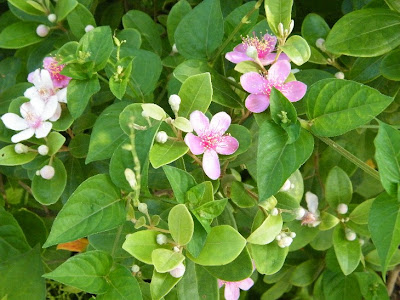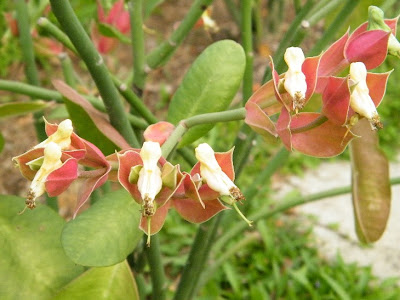 This was a very free flowering plant that I bought and displayed in HortPark's Home Garden until my colleague came and took it away a year ago.
This was a very free flowering plant that I bought and displayed in HortPark's Home Garden until my colleague came and took it away a year ago.31 January 2010
EPIPHYLLUM OXYPETALUM
 This was a very free flowering plant that I bought and displayed in HortPark's Home Garden until my colleague came and took it away a year ago.
This was a very free flowering plant that I bought and displayed in HortPark's Home Garden until my colleague came and took it away a year ago.WHITFIELDIA
DEATH
PAGIANTHA DICHOTOMA
 I posted about the transplanting of this Pinwheel Flower tree recently to Floral Walk.
I posted about the transplanting of this Pinwheel Flower tree recently to Floral Walk.Whilst this tree is relatively free flowering, I have never seen it fruit in Singapore. When I visited the Malaysian nursery last year, I saw lots of fruits on the small trees. I thought the pollinator may not be present in abundance down south in Singapore, hence the lack of fruit production.
Imagine my surprise when I saw a pair of familiar yellow crescent fruits, typical of plants from the Family Apocynaceae, from afar at the corner of the Garden Of Seasons on 17 Jan 10. Though the tree was small with only a few branches and leaves, there was a pair of the fruits. Now I shall wait till the fruits are ripe before I collect the seeds.
GARDEN OF SEASONS
RHODOMYRTUS TOMENTOSA
CISSUS
30 January 2010
SYZYGIUM
CLERODENDRUM QUADRILOCULARE
 This is a pretty unusual Clerodendrum that I first saw in the nursery. Then I saw lots of it in Chiang Mai and bought back quite a few large ones over 1.5 m tall.
This is a pretty unusual Clerodendrum that I first saw in the nursery. Then I saw lots of it in Chiang Mai and bought back quite a few large ones over 1.5 m tall.The upperside of the leaves is green but the underside is magenta. The cluster of flower buds start out small, but slowly develop to produce long tubular pink flowers with a bulbous tip. At this stage, the flowers remind me of cotton buds and the magenta external surface of the sepals also contrast strongly with the pink flowers.
BIRDS
 When I drove past the Nursery Holding Area on 15 Jan 10, I was drawn to some rustling movement amongst the low grass weeds growing from the laterite layer.
When I drove past the Nursery Holding Area on 15 Jan 10, I was drawn to some rustling movement amongst the low grass weeds growing from the laterite layer.
I stopped on my buggy and observed from a distance. Then I realized they were actually birds feeding on the seedheads of the grasses. There were groups of Spotted Doves and Munias.
Everytime I drove the buggy closer to take their photos, they took off further away from me. Eventually, I managed to get some photos of them.
MISTLETOE & EGGS
 My colleagues informed me on 15 Jan 10 of this cluster of eggs found on the parasitic plant mistletoe near the Nursery Holding Area of HortPark.
My colleagues informed me on 15 Jan 10 of this cluster of eggs found on the parasitic plant mistletoe near the Nursery Holding Area of HortPark.
 Before I get to the eggs, I must highlight that the small mistletoe flowers are really unusual.
Before I get to the eggs, I must highlight that the small mistletoe flowers are really unusual.Below the thick leathery leaves were clusters of eggs, which were likely from the butterfly Painted Jezebel. I am in fact rather surprised to see that the butterfly actually laid its eggs on this plant in a bright open sun area. I would have thought it would lay its eggs at a place where it is more protected.
CLERODENDRUM MYRICOIDES 'UGADENSE'
EUPHORBIA COALCOMANENSIS
 Planted next to the sub-station of HortPark at the Pasir Panjang entrance just before Clean and Green Singapore 2009 in November, this newcomer Candle Cactus or Bird Flower Plant in the nursery landscape was an instant delight to some.
Planted next to the sub-station of HortPark at the Pasir Panjang entrance just before Clean and Green Singapore 2009 in November, this newcomer Candle Cactus or Bird Flower Plant in the nursery landscape was an instant delight to some.
Known to grow to more than 2 m tall in its native habitat, it produces masses of red bracts under full sun and contains the interesting bird-like flower within. Close-up, the creamy flower is shaped like a small bird perched on the plant with the numerous stamens and brown anthers as the tail end of the bird.
BARRINGTONIA
 Taken on 14 Jan 10 along Pasir Panjang Road, this Barringtonia is really awesome. Though not a frequent bloomer, this uncommon tree produces pendulous clusters of relatively large pink flowers with long visible stamens held by a ring of star-like petals reminiscent of sea anemones when viewed close-up.
Taken on 14 Jan 10 along Pasir Panjang Road, this Barringtonia is really awesome. Though not a frequent bloomer, this uncommon tree produces pendulous clusters of relatively large pink flowers with long visible stamens held by a ring of star-like petals reminiscent of sea anemones when viewed close-up.23 January 2010
PSEUDOGYNOXYS CHENOPODIOIDES
 These photos of the Mexican Flame Vine were taken on 13 Jan 10 at the HortPark's Home Garden.
These photos of the Mexican Flame Vine were taken on 13 Jan 10 at the HortPark's Home Garden. Previously known by its synonym Senecio confusus, this beautiful climber is one of my new favourites because I love the orange colour.
Subscribe to:
Posts (Atom)








































